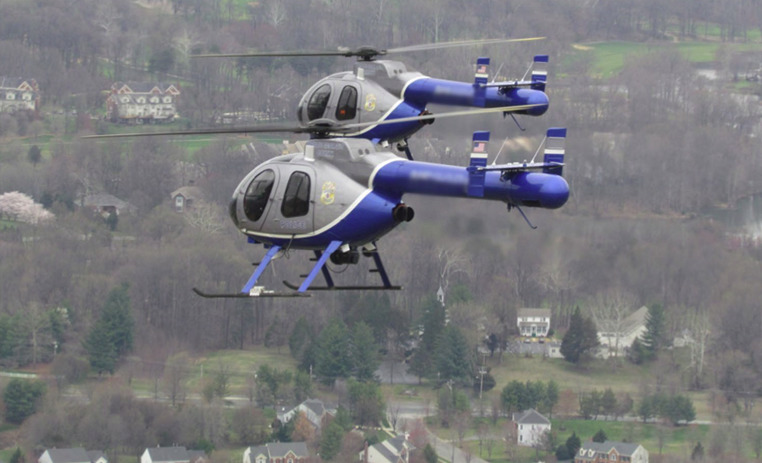With about 30,000 helicopter flights near Washington, D.C., each year, helicopter noise is a real issue, but resident complaints won’t quiet the skies as most flights are conducted by the military and all must follow narrow corridors through highly restricted airspace, according to a new government watchdog report.
From 2017 to 2019, more than 50 operators flew 88,000 helicopter flights within 30 miles of Ronald Reagan National Airport, across the Potomac River from Washington, according to a Government Accountability Office study of helicopter noise published Jan. 7.

Congress requested the GAO study helicopter noise in and around the U.S. capital and recommend how the FAA might mitigate the racket, which “can potentially expose members of the public to a variety of negative effects, ranging from annoyance to more serious medical issues.”
D.C. hears a disproportionate amount of rotorcraft traffic, with military, air medical, and federal, state and local law enforcement helicopters airborne almost daily. In the last three years, helicopter flights over Washington, D.C., have decreased even as area residents have ever more publicly decried the noise they cause.
All of that traffic probably sounds louder to area residents because operators must fly low and slow to abide by security restrictions in the tightly controlled airspace, GAO found. Still, FAA data indicate the number of annual flights in the D.C. area decreased slightly from about 31,000 in 2017 to 29,000 in 2019.
“While the number of flights has decreased slightly over the three years reviewed, it is unknown whether there has been a change in helicopter noise in the area,” the GAO report said. “Most stakeholders do not collect noise data, and existing studies of helicopter noise in the area are limited. D.C. area airspace constraints — such as lower maximum altitudes near urban areas — combined with proximity to frequently traveled helicopter routes and operational factors may affect the noise heard by residents.”

Of the regular operators in D.C. skies, the military is responsible for the majority of operations. Of the 88,000 flights counted between 2017 and 2019, military aircraft from all services were responsible for 37.4 percent or 32,890 flights. GAO interviewed Air Force, Army, Army National Guard, Coast Guard, and Marine Corps operators for the report.
“Military operators generally use helicopters to transport officials, conduct air defense and consequence management operations, and train flight crews,” the GAO report said.
That includes the VH-3D presidential helicopter — and its replacement the VH-92 — that frequently flies at a few hundred feet above the Potomac between the White House and Joint Base Andrews carrying the president and his entourage to and from Air Force One.
Air medical flights — Air Methods, MedStar Washington Hospital Center and PHI Health — were the next most numerous at 20.9 percent, or 18,322 flights. In descending order, “other aviation activity” came next followed by state/local law enforcement, federal agencies and news helicopters. The “other” category consists of tourism and charter operations, for which GAO interviewed Monumental Helicopters, which operates a Robinson R44 out of Fort Meade, Maryland.
State and local law enforcement include the D.C. Metro Police, nearby county police departments and both the Virginia and Maryland State Police. Customs and Border Protection, the Department of Energy, FBI and U.S. Park Police all regularly operate helicopters near the city, as well.
Several weeks of near-constant overflights by Department of Energy Bell 412 helicopters testing the air for unnatural radiation ahead of the upcoming presidential inauguration had residents up in arms and circulating conspiracy theories.
Both the FAA and operators regularly receive noise complaints from residents, but those gripes are not regularly communicated, GAO found. In both the D.C. area and throughout the United States, FAA responds to helicopter noise concerns through regional offices connected with its Aviation Noise Ombudsman, which determines if helicopter activity violated any orders, regulations or laws.

“FAA’s and operators’ approach to addressing these issues in the D.C. area is impeded because they do not consistently or fully share the information needed to do so,” the GAO report says. “According to nearly all the operators we interviewed, FAA has not communicated with operators about helicopter noise or forwarded complaints to them. Similarly, operators often receive noise complaints from the public — some complaints are not directed to the correct operator — but do not typically share these complaints with FAA.”
GAO found that most operators in the D.C. area had adopted some of the “Fly Neighborly” guidelines — promoted by Helicopter Association International (HAI) in partnership with the FAA — to reduce the impact of aircraft noise on residential areas. They include avoiding rapid and high-angle turns, practicing steeper landing approaches and flying at the maximum allowed altitude.
“Many operators also reported mitigating helicopter noise by following the helicopter route structure, noting that the location of the routes over roadways and waterways help shield residential neighborhoods from helicopter noise,” the GAO report said. “However, according to FAA officials, the route structure was not designed to mitigate helicopter noise but instead was intended to safely manage the helicopter and fixed-wing traffic in the D.C. area airspace.”
With little other recourse because of the operating environment around D.C., the GAO is recommending that the FAA and operators better communicate noise complaints. It suggests that the FAA Administrator direct the Office of Environment and Energy to develop a mechanism to exchange helicopter noise information with operators in the D.C. area.








